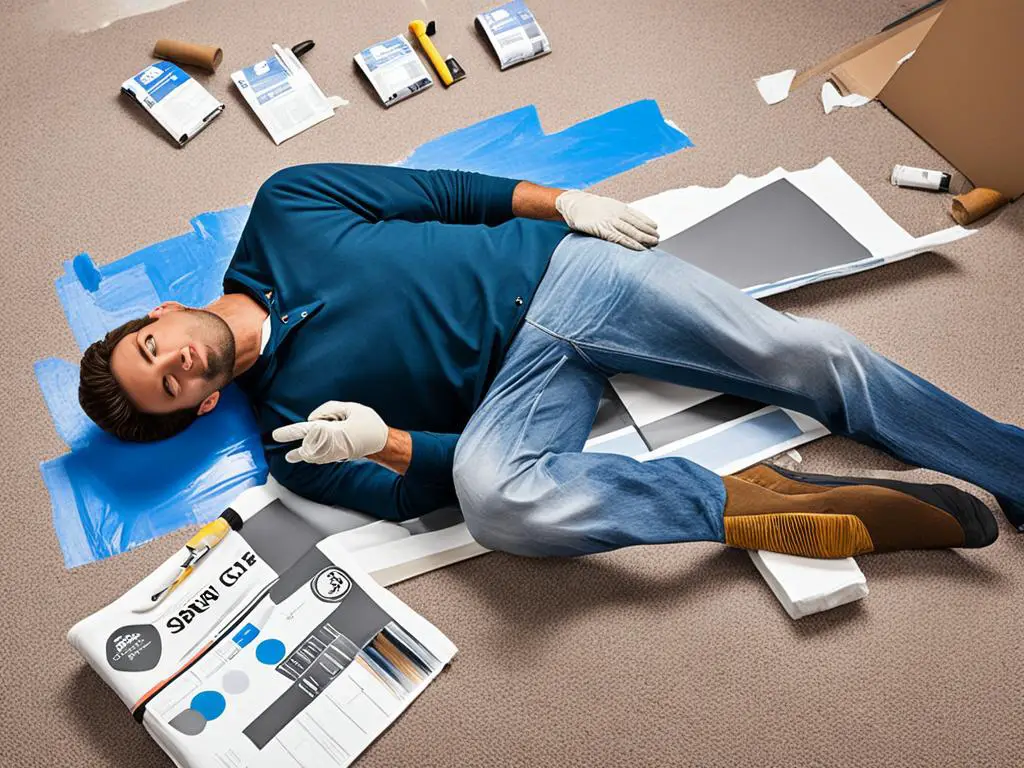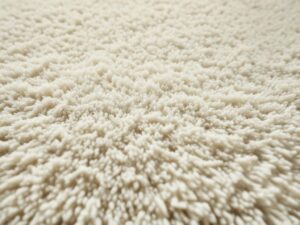Protecting your carpet while painting is essential to prevent stains and costly replacements. By taking some simple precautions, you can keep your floors clean and pristine during your painting project. Here are some tips to help you protect your carpet:
Key Takeaways:
- Cover your carpet to prevent paint spills.
- Protect the trim to keep the carpet clean.
- Allow paint to dry completely before uncovering the carpet.
- Act quickly to clean up any paint spills on the carpet.
- Consider hiring professional painters for expert carpet protection.
Cover the Carpet to Prevent Paint Spills
Before you start painting, it’s important to cover your carpet to avoid any accidental spills. By taking this precaution, you can safeguard your carpet and prevent unsightly stains. Here are some carpet-saving techniques to help you protect your flooring during your painting project:
- Remove any furniture or rugs that can be easily moved out of the room. This will create more space and make it easier to cover the carpet effectively.
- Use polythene dust sheets or old sheets to cover the carpet. Make sure to choose materials that are thick enough to prevent paint from soaking through and contacting the carpet underneath.
- Securely tack down the corners and walls of the sheets with painter’s or masking tape. This will ensure that the sheets stay in place throughout the painting process.
By following these simple steps, you can effectively protect your carpet from paint spills and keep it looking clean and pristine. Remember to take the time to cover your carpet properly before you begin painting to avoid any unnecessary damage.
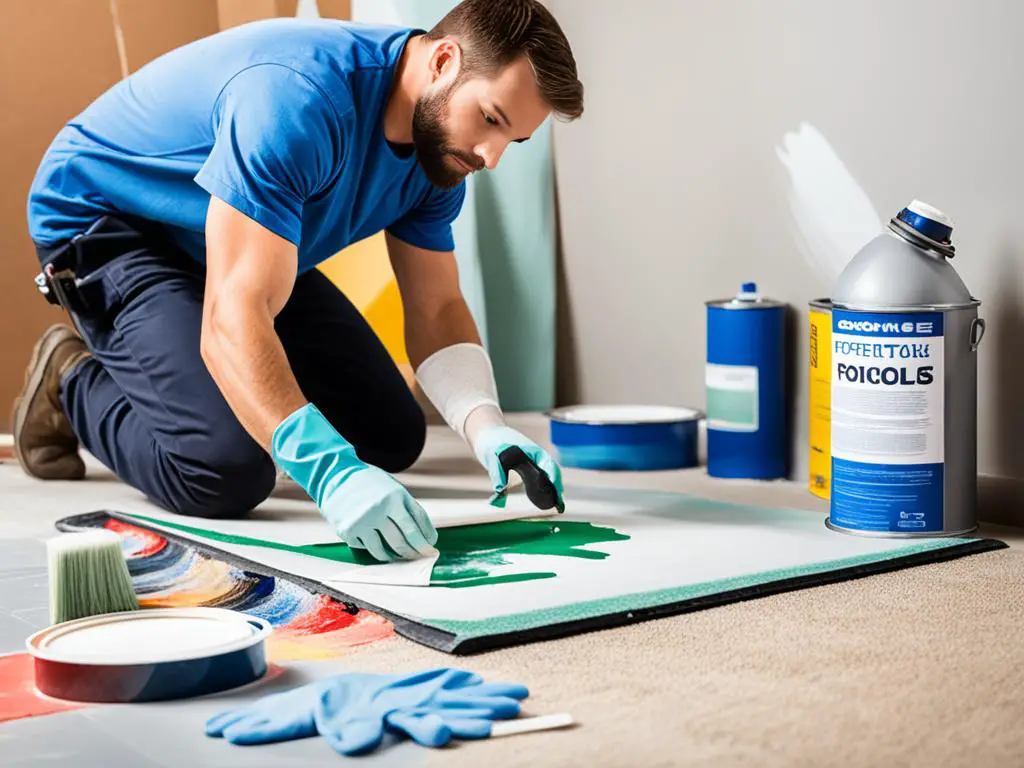
| Techniques | Effectiveness | Level of Difficulty | Cost |
|---|---|---|---|
| Using polythene dust sheets | High | Easy | Low |
| Using old sheets | Moderate | Easy | Low |
| Securing corners and walls with painter’s or masking tape | High | Easy | Low |
When it comes to carpet protection during painting, taking the right steps can make all the difference. The table above provides a comparison of different carpet-saving techniques based on their effectiveness, level of difficulty, and cost. By using polythene dust sheets or old sheets and securing them with painter’s or masking tape, you can effectively safeguard your carpet without spending a fortune.
Protect the Trim as Well
In addition to covering the carpet, it’s also important to protect the trim. By taking extra precautions, you can ensure that both the trim and the carpet remain clean and undamaged during your painting project.
Tape polythene sheets a little higher to create a protective barrier for the trim and carpet. This will prevent any accidental paint drips from staining the trim or seeping onto the carpet. It’s crucial to secure the polythene sheets tightly to ensure complete coverage.
Use painter’s tape to create smooth and well-secured lines where the trim meets the rest of the wall. This will create a clear boundary and prevent any paint from getting on the trim. Painter’s tape is easy to apply and remove without leaving any residue or damaging the surfaces.
Why Protecting the Trim Matters
Protecting the trim is essential for achieving a professional-looking paint job. Paint splatters or drips on the trim can ruin the overall aesthetic of the room and require additional touch-ups. By taking the time to protect the trim, you can ensure clean lines and a beautifully finished result.
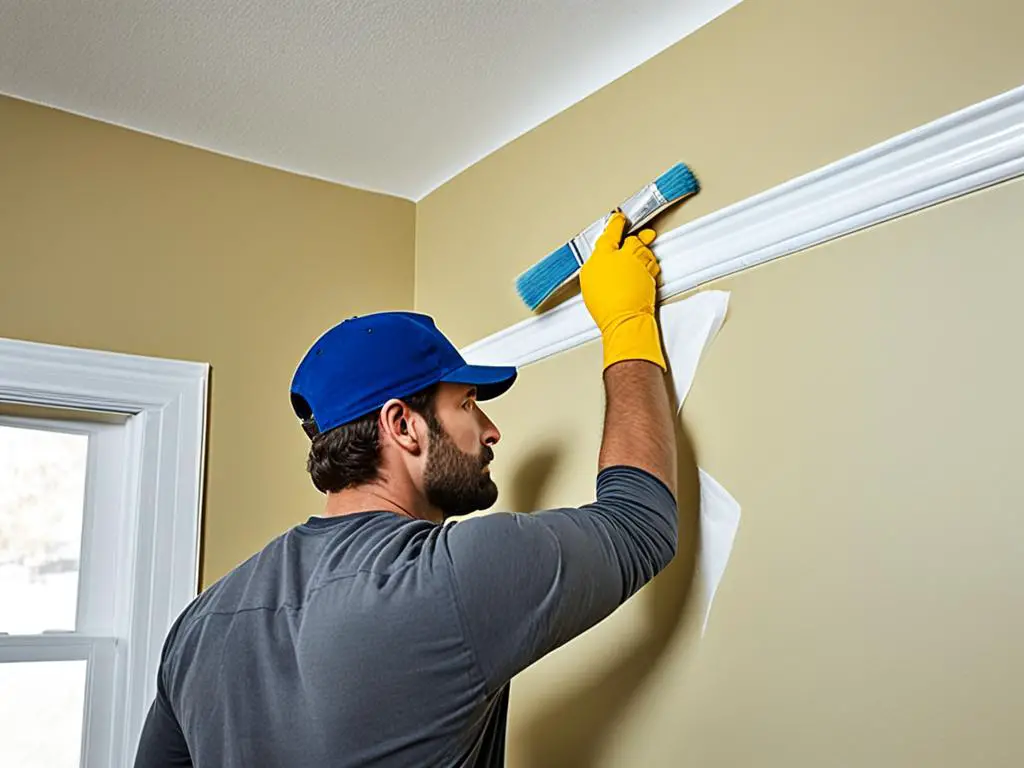
It’s important to note that different types of trim may require different protection methods. For delicate trim or intricate designs, consider using delicate surface painter’s tape or masking tape with low adhesive strength. This will allow for easier removal without damaging the trim.
To further protect the trim, you can also use a trim guard or trim protector tool. These tools create a physical barrier between the trim and the wall, preventing any paint from reaching the trim. Trim guards are particularly useful for hard-to-reach areas or corners.
Remember, taking the extra step to protect the trim will not only prevent paint stains but also save time and effort in the long run. It ensures that your painting project results in a clean and professional-looking finish without any damage to the trim or carpet.
Be Patient and Allow Paint to Dry Completely
Once you have finished painting your walls, it’s important to exercise patience and allow the paint to dry completely before uncovering the carpet or moving furniture back into the room. This step is crucial to avoid any potential damage to your carpet and to prevent paint spills from occurring.
Wet paint can easily transfer onto the carpet if it comes into contact with it before drying. This can result in permanent stains and costly damage that may require professional cleaning or even replacement of the carpet. To prevent this, give the paint ample time to dry before you resume normal activities in the room.
To ensure a smooth and undisturbed drying process, follow these steps:
- Limit access to newly painted rooms: Restrict access to the painted room to prevent accidental contact with wet paint. This will help minimize the risk of paint splatters or footprints on the carpet.
- Provide proper ventilation: Open windows or use fans to facilitate air circulation in the room. Adequate ventilation helps speed up the drying process and reduces the chances of paint odors lingering in the space.
To give you a better idea of how long different types of paint take to dry, refer to the table below:
| Type of Paint | Average Drying Time |
|---|---|
| Latex-based paint | 1-2 hours to touch, 1-2 weeks to fully cure |
| Water-based paint | 1-2 hours to touch, 2-3 weeks to fully cure |
| Oil-based paint | 4-6 hours to touch, 2-3 weeks to fully cure |
Remember, drying times can vary depending on factors like temperature, humidity, and the number of paint coats applied. It’s always a good idea to check the paint can labels for specific drying instructions.
By taking the time to allow paint to dry completely, you can avoid any potential damage to your carpet and ensure that your painting project has a successful and clean finish.
Expert Tip:
For added protection, keep the carpet covered until you are confident that the paint has thoroughly dried. This extra precaution can help prevent any accidental mishaps and keep your carpet in pristine condition.
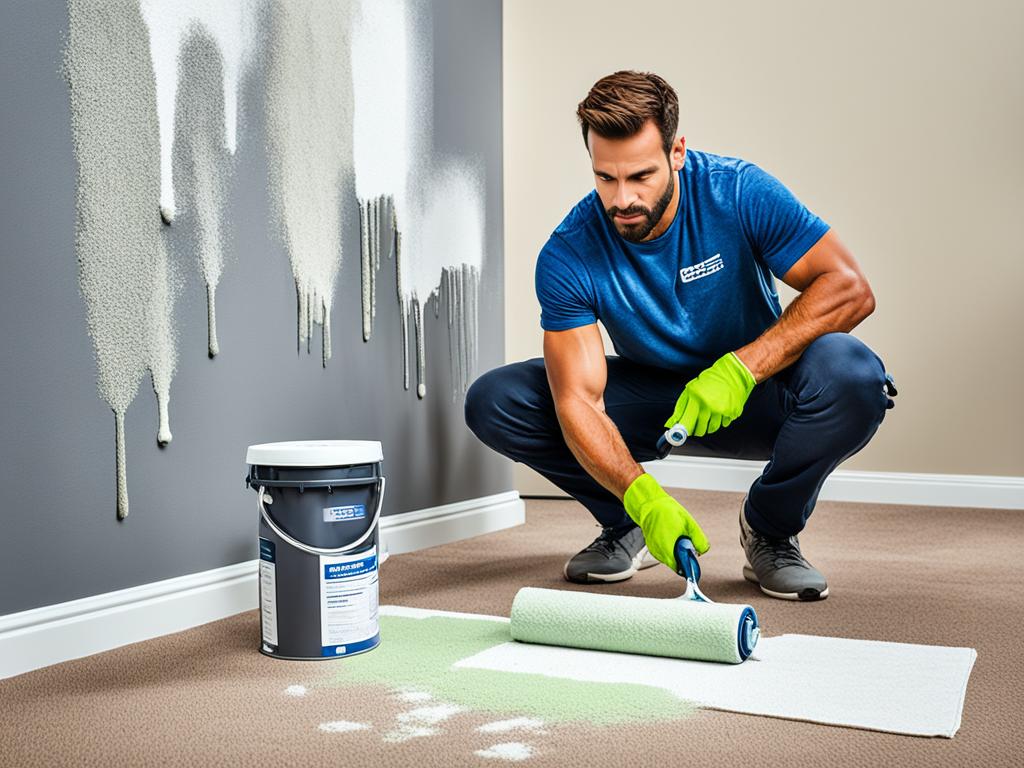
Dealing with Paint Spills on Carpet
If a paint spill does occur on your carpet, it’s crucial to act quickly to prevent it from setting in and drying permanently. The proper cleaning method will depend on the type of paint spilled. Here are some recommended techniques:
- Latex-based paints: Gently work away at the spill with a mixture of detergent and warm water. Blot the area using a clean cloth or sponge. Repeat the process until the paint is completely removed from the carpet fibers.
- Water-based paints: Mix equal parts water and vinegar, then apply the solution to the paint spill. Blot the area with a clean cloth or sponge, continuously lifting the paint from the carpet.
- Acrylic paints: Treat acrylic paint spills by applying glycerin to the affected area. Let it sit for a few minutes, then gently blot the paint, starting from the outer edges and moving inward.
- Oil paints: For oil-based paint spills, use a clean cloth or sponge soaked in alcohol or turpentine. Blot the spill carefully, working from the outer edges toward the center to avoid spreading the paint further.
Remember to test any cleaning method on an inconspicuous spot of the carpet first to ensure it does not cause damage or discoloration. If the paint spill is extensive or difficult to remove, it’s best to seek professional carpet cleaning services.
Additional Tips for Carpet Protection
Aside from using polythene sheets, there are various other materials and techniques you can employ to effectively safeguard your carpets during painting projects. These carpet protection hacks will help prevent damage and ensure your carpets remain in pristine condition.
Alternative Materials for Flooring Protection
If you’re looking for alternatives to polythene sheets, consider using the following materials to cover and shield your flooring:
- Hardboard sheets: These rigid and durable boards create a sturdy surface for your painting equipment and furniture to move across smoothly. Simply tape them down securely to ensure they stay in place.
- Thick paper: Opt for thicker or construction-grade paper to provide an extra layer of protection against spills and paint drips. Similar to polythene sheets, tape these down securely to avoid slippage.
- Thick plastic sheeting: Heavy-duty plastic sheeting offers excellent resistance to paint spills and can be easily cut to fit the dimensions of your room. Use tape to secure the edges and corners for added stability.
These materials not only shield your carpets from paint damage, but they also create a smooth surface, allowing for easy movement of chairs, painting equipment, and other objects during your project.
Ready-Made Rug Fragments and Large Rugs
Another option for protecting your carpets is to utilize ready-made rug fragments or large rugs. These can be sourced from consignment stores or second-hand shops. By strategically placing these rugs in high-risk areas, you can ensure more extensive coverage and safeguard your carpets from accidental paint spills or marks. Additionally, the rugs can be easily removed and cleaned once your painting project is complete.
Remember, prevention is key when it comes to protecting your carpets during painting projects. By taking these additional measures, you can minimize the risk of damage to your carpets and enjoy a stress-free painting experience.
| Material | Benefits |
|---|---|
| Hardboard Sheets | Create a smooth surface for easy movement of equipment |
| Thick Paper | Extra layer of protection against spills and drips |
| Thick Plastic Sheeting | Heavy-duty resistance to paint spills and easy to cut to size |
| Ready-Made Rug Fragments and Large Rugs | Safeguard carpets from accidental spills and marks |
Professional Help for Carpet Protection
If you want to ensure the utmost protection for your carpet during painting, it’s worth considering hiring professional painters. Professional painters are experienced in securing protective tape and tarps, and they have the skills to complete a clean and precise paint job that extends only to your walls and not your carpet. Contact a reputable painting company to get expert assistance for protecting your carpet.
Benefits of Hiring Professional Painters
- Expertise in carpet-saving techniques
- Efficient and precise paint application
- Professional-grade protective materials
- Reduced risk of carpet damage
- Save time and effort
By hiring professional painters, you can ensure that your precious carpet remains safe during the painting process. These experts have in-depth knowledge of carpet protection techniques and will employ best practices to safeguard your flooring. They will use high-quality protective materials, such as heavy-duty tarps and specialized tapes, to create a barrier between your carpet and the paint. Their experience and skill will enable them to complete the paint job without any accidental spills or damage to your carpet.
“Hiring professional painters for carpet protection is a wise investment. It gives you peace of mind knowing that your carpet will be well-protected during the painting process.”
Additionally, professional painters can provide valuable advice and recommendations on the best carpet-saving techniques based on the type and condition of your carpet. They can assess potential risks and implement preventive measures to avoid any potential damage. With their expertise and attention to detail, you can trust that your carpet will remain pristine throughout the painting project.
When selecting a professional painting company, be sure to choose a reputable and experienced service provider. Look for customer reviews and testimonials to ensure their reliability and skill. Take the time to discuss your carpet protection concerns with the painters and inquire about their methods and materials. By hiring professionals, you can achieve a flawlessly painted space while keeping your carpet in top condition.
| Reasons to Hire Professional Painters for Carpet Protection | Benefits |
|---|---|
| Expertise in carpet-saving techniques | Ensures proper protection and prevents damage |
| Efficient and precise paint application | Avoids accidental spills and splatters on the carpet |
| Professional-grade protective materials | Creates a reliable barrier between paint and carpet |
| Reduced risk of carpet damage | Maintains the integrity and appearance of the carpet |
| Save time and effort | Allows you to focus on other aspects of the project |
Conclusion
By following these essential carpet protection tips, you can successfully safeguard your carpet during painting projects. Taking the time to cover the carpet, protect the trim, allow paint to dry completely, and promptly address any spills will help you maintain clean and stain-free floors. Whether you choose to hire professional painters or tackle the project yourself, these tips will ensure that your carpet remains in excellent condition while giving your walls a fresh new look.
Remember, when beginning a painting project, cover your carpet with polythene dust sheets or old sheets secured with painter’s tape. This will prevent any accidental spills from soaking through and damaging the carpet. Additionally, protect the trim by taping polythene sheets higher to create a barrier between the paint and the area where the trim meets the wall.
After completing your painting project, exercise patience and allow the paint to dry completely before uncovering the carpet or moving furniture back into the room. This will prevent any wet paint from coming into contact with the carpet and causing damage. If a paint spill does occur, quickly address it using appropriate cleaning methods specific to the type of paint spilled, such as detergent and warm water for latex-based paints or a mixture of water and vinegar for water-based paints.
By implementing these carpet protection techniques, you can enjoy the process of painting without worrying about damaging your carpet. These tips will not only save you from costly replacements but also help maintain the beauty and longevity of your carpets.
FAQ
How can I protect my carpet when painting?
To protect your carpet when painting, cover it with polythene dust sheets or old sheets. Securely tape down the corners and walls with painter’s or masking tape to prevent any accidental spills from soaking through and contacting the carpet underneath.
Should I protect the trim as well?
Yes, it’s important to protect the trim when painting to prevent any paint from getting on it. Tape polythene sheets a little higher to protect both the trim and the carpet. Use painter’s tape to create smooth and well-secured lines where the trim meets the rest of the wall.
How long should I wait before uncovering the carpet or moving back furniture after painting?
It’s crucial to be patient and allow the paint to dry completely before uncovering the carpet or moving back furniture. This will prevent any wet paint from coming into contact with the carpet and causing potential damage. Limit access to newly painted rooms and ensure proper ventilation to facilitate a timely and undisturbed drying process.
What should I do if a paint spill occurs on my carpet?
If a paint spill occurs on your carpet, it’s important to act quickly. The proper cleaning method will depend on the type of paint spilled. For latex-based paints, gently work away at the spill with a mixture of detergent and warm water. Water-based paints can be cleaned with a mixture of water and vinegar. Acrylic paints can be treated with glycerin, while oil paints may require the use of alcohol or turpentine. Always test cleaning methods on an inconspicuous spot first to avoid damaging the carpet.
Are there any additional tips for carpet protection during painting?
Yes, in addition to using polythene sheets, you can also consider using hardboard sheets, thick paper, or thick plastic sheeting to cover and protect your flooring during painting. These materials provide a robust and smooth surface for easy rolling of chairs and other equipment. Additionally, you can purchase ready-made rug fragments or large rugs from consignment or second-hand stores for more extensive coverage.
Should I consider hiring professional painters to protect my carpet?
If you want to ensure the utmost protection for your carpet during painting, it’s worth considering hiring professional painters. Professional painters are experienced in securing protective tape and tarps, and they have the skills to complete a clean and precise paint job that extends only to your walls and not your carpet. Contact a reputable painting company for expert assistance in protecting your carpet.
How can I safeguard my carpet during painting projects?
By following these carpet protection tips, you can successfully safeguard your carpet during painting projects. Cover the carpet with protective sheets, protect the trim, allow the paint to dry completely, and quickly address any paint spills to keep your floors clean and free from stains.
